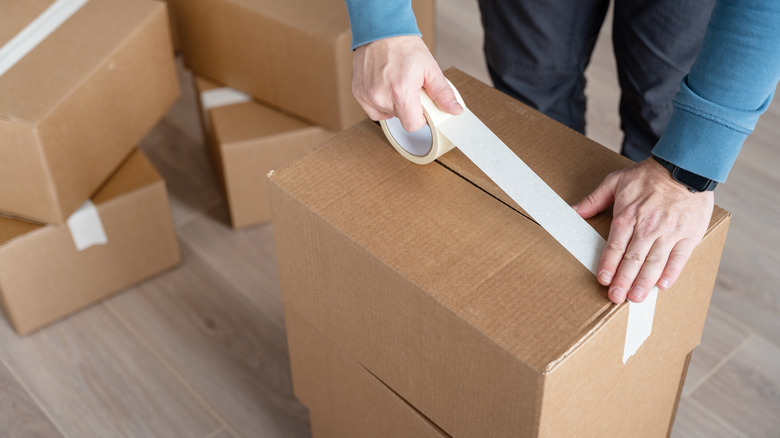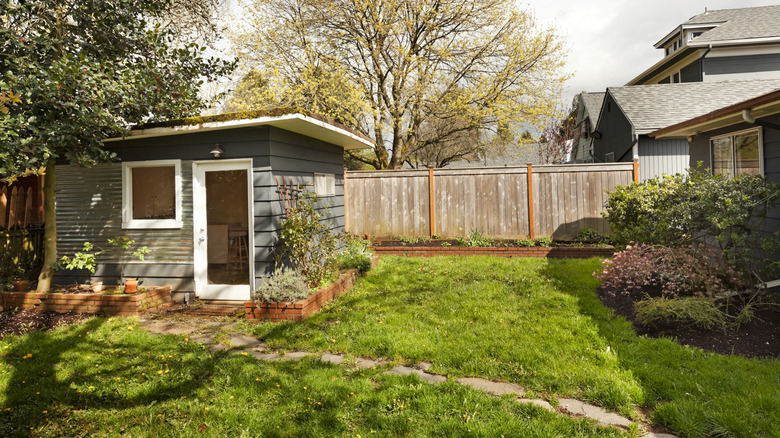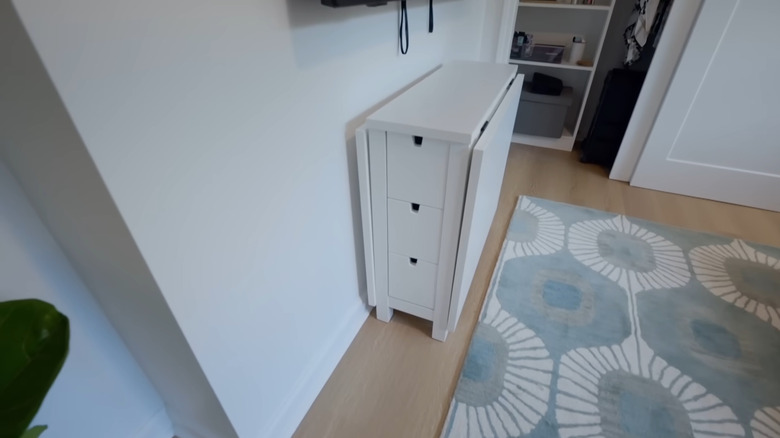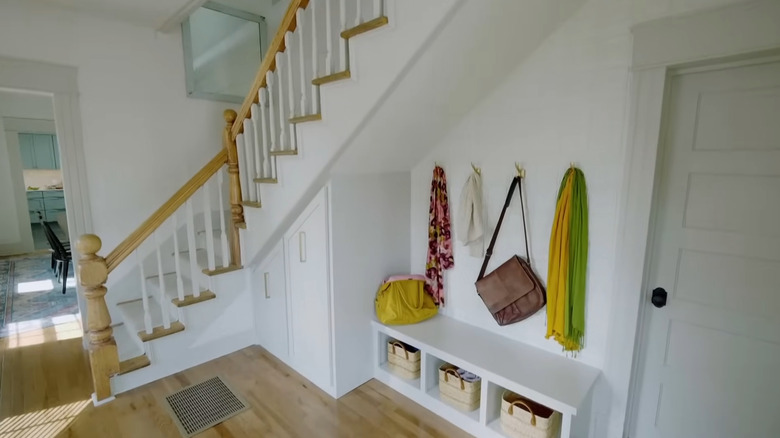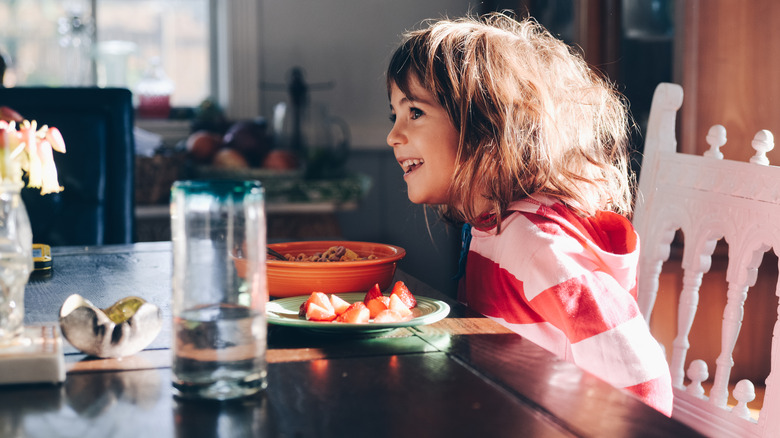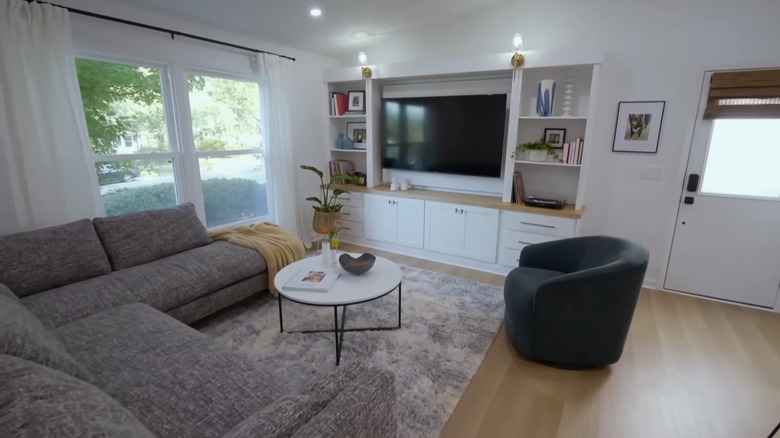HGTV Star Hilary Farr Shares Her Tips For Decluttering Your Home
We may receive a commission on purchases made from links.
Hilary Farr is known for hating clutter. In nearly every episode of "Tough Love with Hilary Farr," the designer challenges the homeowners to ruthlessly declutter their homes before she begins renovating. While her designs might help a room become more functional or expansive, they're not miracle workers. Meaning that if a room is overrun with clutter, she can't carve out enough organizational space to make it all fit. Because of this, she asks the homeowners to really edit their belongings and only keep what they truly like and need. She gives them tips along the way to help them in the process, and we can all learn from her nuggets of wisdom. After all, clutter can creep up on you pretty quickly, and it's sometimes difficult to understand how to part ways with things that are no longer serving us.
Farr's advice runs the gamut. If she sees extreme disorganization issues, she recommends going full throttle and donating or selling unnecessary items. But if she notices a family dealing with necessary clutter — i.e., items used in daily life, but not always wanted to be visible — she suggests gentler tidying solutions. For instance, she likes using multi-functional furniture to conceal frequently used items, or outdoor storage to allocate things that you don't use often, but can't part with. If you feel like you could use some "tough love" for your own clutter issues, read on for Farr's best tips.
Return or donate anything that's a duplicate or doesn't work
We've all been guilty of hoarding more than we should. For instance, maybe you have something of an online shopping habit, but don't find the time to return things that aren't a good fit. This means that unwanted items are littering your closets, taking up space, and collecting dust. If you want to declutter, Hilary Farr has strict advice that will help maximize space in your home: Return or donate anything that's a duplicate or doesn't work. In Season 2, Episode 7 of "Tough Love with Hilary Farr," the designer noticed a clutter problem in the house she was going to redesign. "Let's just find solutions," Farr told the homeowners. "It means maybe bagging them [excess items] up and giving them away. There are all sorts of places where women would be so thrilled if you could donate that."
To do this in your own home, go from room to room and collect anything that is a duplicate or doesn't work. For the latter, that can be clothes that are too big or small, or items that you have no use for or are broken. Corral these items in a pile. For the duplicates, select one or two items to keep, and for the rest, you can either donate, return, or sell. For the items that no longer serve a purpose for you, donate or sell them on secondary markets like Facebook Marketplace.
Declutter whenever someone moves in or out
It can be difficult to find the time (and willpower) to declutter. Some might do it once a year during spring cleaning, but if you have to do it on a whim, it might be challenging to find the energy to take on such an endeavor. Farr understands this, which is why she recommends triggering the action during a big house shakeup, such as when someone moves in or out. If you're moving out, it's the perfect opportunity to edit out clutter rather than packing it into boxes. If someone is moving in, you can assess what should be cut to make space for the new partner or roommate. In Season 2, Episode 7, Farr was tasked with redesigning a house for Ann and Ronnie, who just moved in together. "When you segued from being single to Ronnie coming in, did you not do a purge then?" Farr asked Ann. "There's never a bad time to do it" (via Realtor.com).
When moving out, assess each item before packing it into a cardboard box. Is it useful, not a duplicate, fits well, isn't broken, and still brings you joy? If so, pack it up. If not, donate or sell it. When someone is moving in, do the same. If you aren't up to decluttering the whole house for their arrival, edit areas they will need access to, such as the bedroom, bathroom, and any storage closets or kitchen cabinets. Ask the same questions to prune out unneeded items.
If you bring something in, you need to toss something out
We all know that limiting our shopping can help reduce the amount of clutter we bring into the house, but sometimes that's easier said than done. If you are constantly tempted to buy new decor items, kitchen gadgets, or clothing, try to curb the amount of stuff you pack into your house by following Farr's one simple rule: If you bring something in, you need to toss something out. This rule was demonstrated in Season 2, Episode 5, when Farr worked with the couple Nicky and Nick, who had a problem with excess toys. While Farr was in the middle of renovating their house, Nicky updated her on their clutter problem. "We had a birthday party and got a whole bunch of new presents, so we got rid of old toys instead of keeping them all," Nicky shared. "There you go: 2 in, 2 out. That's going to make a big difference," Farr said (via Realtor.com)
To implement this in your own home, remind yourself you will need to donate or sell something in order to get the item you want. Before going up to the register or hitting "purchase," make a mental note of what you can weed out. This will not only help you continually declutter, but it might also slow down your spending and accumulation of "stuff." If there is nothing you want to give away, then you shouldn't purchase the new item.
Store things you can't part with outside of the house
Sometimes decluttering is easier said than done. If you struggle to part with your belongings or have already done a significant purge, but still have a surplus, then Farr has a workaround for you. Rather than keeping the clutter packed inside your house, consider moving it to a separate storage shed. In Season 2, Episode 7, Farr suggests that the homeowners implement a separate storage unit in their backyard to house all the extra odds and ends they aren't ready to donate or still have use for. This allows for their closets and cabinets to be more well organized.
Since this storage shed will mainly be used to house boxes, it doesn't have to be very large. For example, the Devoko Outdoor Storage Shed is 5 feet wide, 6 feet tall, and 3 feet deep, allowing you to stack a decent amount of weatherproof storage bins inside. It's also moisture-proof, so rain and snow won't affect the contents inside, and it has a lock, allowing you to secure it. It's also an affordable storage solution, clocking in at $125 on Amazon. This not only declutters your home, but it might also convince you to toss the contents you plan to store outside. If they're out of your house and you don't need them for months on end, you might be persuaded to donate or sell them.
Choose furniture pieces with hidden storage to hide clutter
Sometimes, clutter can't be helped. You might need a surplus of items for the kitchen, your crafts, or your work. For cases like that, Farr thinks it's best to find innovative storage solutions, so they're out of sight but well organized. In Season 2, Episode 7, homeowners Ann and Ronnie had a multi-purpose room that was both her office space and a guest bedroom. She was a makeup artist and needed ample storage to organize her cosmetics, but having them out in the open would make it look cluttered. As a workaround, Farr sourced a slim cabinet with drawers that doubled as a table. All you have to do is lift the table top into place when using it, and then fold it back down to the side of the cabinet when not.
You can do the same in your home by figuring out which rooms have an issue with clutter that you can't prune. For example, if your living room is over-run with toys, but you know your kids will constantly bring them out, you can source storage ottomans that can corral the playthings. That way, they're still contained in the room and are in easy reach, but they're not out on display when the kids aren't playing. Similarly, if you have a lot of decorative pillows on your bed or couch, and want to avoid throwing them on the floor, you can store them in a storage bench at the foot of the bed or near the sofa.
Create extra storage in dead spaces
Sometimes useful items can feel like clutter when they're all out on display in a messy manner. Take your entryway, for example. If you have coats and shoes that aren't housed in a neat system, then they can make the area appear overwhelming. To avoid this, Farr suggests carving out extra storage in dead spaces, like underneath the stairs. In Season 2, Episode 5, the homeowners have a large staircase in their foyer. They were utilizing that space with a standalone bench and open shoe storage, but Farr transformed it into more comprehensive storage by creating a closet system. Cabinets were built under the stairs, and a built-in bench with cubbies was added to the end. That way, the clutter was hidden behind a uniform storage system, making it appear less overwhelming.
If you don't have stairs, there are other dead zones you can utilize. For instance, if you have a garage, you can create storage on the ceiling by investing in mounted bin racks, such as the KOOVA mounted storage unit, which retails for $130 at Home Depot. These steel racks can attach three storage bins to the ceiling. In the kitchen, you can carve out extra organization space by transforming toe kicks into drawers with an installation kit, such as this one on Amazon. If you're not keen on a big DIY project, don't worry. You can also do something as simple as creating extra storage on cabinet doors with hanging baskets or stick-on hooks.
Don't commit to too much furniture for kids
We want to ensure our kids feel comfortable and included in our communal living spaces, but if you want to reduce clutter, reduce the amount of kid furniture you have. These pieces are very temporary, since kids grow quickly, and they make a room feel too crowded with items. For this reason, Farr recommends cutting them out of the picture. In Season 2, Episode 5, Farr questions why the homeowner wants to add extra kid seating to the kitchen via a banquette. "There's seating at the island, seating at the dining table. Where and why would you want a banquette and the table there?" she asked. When the mom voiced her concern that the kids wouldn't be comfortable in the adult seating, Farr replied, "It's very temporary. They grow very fast. We're not doing a banquette and table there."
If you similarly lean towards getting extra furniture for your kids, take a minute and see if you actually need it. As Farr pointed out, there is plenty of seating at one's island or dining table that the kids can utilize. If you feel like the seats aren't safe for their age, see if you can swap the chairs for more kid-friendly versions. For example, changing uncomfortable metal chairs to wide cushioned seats helps to contain them. Or consider switching bar stools for counter stools with backs and arms to make it safer for them to perch.
Avoid buying things for future purposes
It's always great to prepare for the future, but planning too far ahead can lead to problems. While it can be helpful to take advantage of sales to buy bulk grocery items or clothes for future seasons or sizes, getting too carried away can create storage issues. Farr recommends avoiding shopping for future needs in order to cut back on these kinds of messes. For instance, in Season 2, Episode 5, when the homeowner saw the extra closet space she got in her son's room, she joked, "I can put his 'to grow into' clothes in here." Farr responded with, "No, stop it. Stop it. No 'to grow into' clothes."
To curb your own over-planning, focus on your current requirements. If this is a challenge, convince yourself to cut back by reviewing your past purchases. On a piece of paper, write down every sale item or "for future use" item you bought that didn't work out. Perhaps you never used it, it was the wrong size, or it wasn't as useful as you anticipated. Seeing a running list of them will help you realize the amount of clutter you're needlessly creating in your home.
Create integrated storage for clutter you can't avoid
There is certain clutter you just can't avoid. For example, if you have pets, you likely have cat and dog toys across your living room. Or if you work from home and don't have a separate office, you might have your setup in the living room. If you don't want chew toys and office files out in the open, then Farr's space-saving solution for this issue is to use integrated storage to hide them. For instance, in Season 2, Episode 7, Farr created a built-in bookcase to house the TV and create a focal point in the living room. But, while doing so, she also ensured the bottom of the built-in had cabinets so the family could hide their living room clutter. "The key here is this built-in," Farr said. "It's all about storage. The things you do need and want now have a place to go without being out all over the place."
A floor-to-ceiling bookcase provides plenty of storage, but if your room doesn't have space for that, there are other ways you can pull off her decluttering idea. One easier alternative is to create an integrated window seat or bench. This bench can either have a flip top that reveals storage inside, or slide out drawers. Depending on what room it's in, it can corral different odds and ends. For example, in a living room it can store everything from blankets to family slippers to puzzles. In a bedroom, it can capture seasonal clothing or bedsheets.


